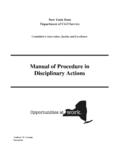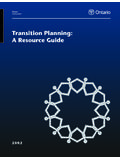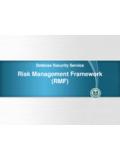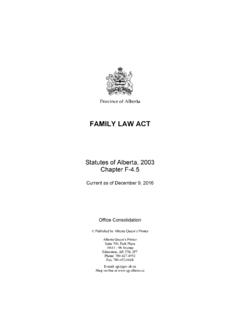Transcription of United States Environmental Office of Solid Waste and ...
1 Page 1 United States Environmental Protection Agency Office of Solid Waste and Emergency Response Office of Enforcement and Compliance Assurance OSWER EPA-540-R-09-001 December 2012 Institutional Controls: A Guide to Planning, Implementing, Maintaining, and Enforcing Institutional Controls at Contaminated Sites 1. PURPOSE The purpose of this guidance is to provide managers of contaminated sites, site attorneys,1 and other interested parties with information and recommendations that should be useful for planning, implementing, maintaining,2and enforcing institutional controls (ICs) for Comprehensive Environmental Response, Compensation, and Liability Act (CERCLA, or Superfund); Brownfields; federal facility; underground storage tank (UST); and Resource Conservation and Recovery Act (RCRA) site cleanups.
2 3 It highlights some of the common issues that may be encountered and provides an overview of EPA s policy regarding the roles and responsibilities of the parties involved in the various life-cycle stages of ICs while 1 The terms site manager and site attorney, as used in this document, refer to personnel from the lead agency involved in a CERCLA (remedial and removal), Brownfields, federal facility, UST, or RCRA cleanup project. Where the lead agency is a federal agency other than the EPA, EPA and the federal agency may share some site manager/site attorney responsibilities or EPA may retain them independently depending on the responsibility under any of the five cleanup programs.
3 The term site is used generically in this guidance to also represent areas of contamination managed under all five of these cleanup programs. The terms CERCLA, and Superfund, generally include both remedial and removal sites. In addition, the term responsible party as used in this document is intended to mean a person or entity with cleanup or IC responsibilities or expectations under the various cleanup programs listed above. 2 The term maintenance refers to those activities, such as monitoring and reporting, that ensures ICs are implemented properly and functioning as intended. 3 This document provides guidance to the Regions on how EPA generally intends to plan, implement, maintain, and enforce institutional controls as part of a cleanup project.
4 While this document relies heavily in many areas on CERCLA-specific terminology and examples, it is intended to provide guidance for all EPA cleanup programs, including RCRA, Brownfields, federal facilities, and underground storage tanks. The guidance is designed to help promote consistent national policy on these issues. It does not, however, substitute for CERCLA, RCRA, or EPA's regulations, nor is it a regulation itself. Thus, it does not impose legally binding requirements on EPA, States , or the regulated community, and may not apply to a particular situation based upon the circumstances. EPA, State, tribal, and local decision-makers retain the discretion to adopt approaches on a case-by -case basis that differ from this guidance where appropriate.
5 Any decisions regarding a particular site will be made based on the applicable statutes and regulations. recognizing that there are some differences among the cleanup programs. This is the second in a series of guidance documents on the use of ICs. The first document, Institutional Controls: A Site Manager s Guide to Identifying, Evaluating and Selecting Institutional Controls at Superfund and RCRA Corrective Action Cleanups, Office of Solid Waste and Emergency Response (OSWER) , EPA 540-F-00-005, September 2000, (A Site Manager s Guide to ICs), provides more detailed guidance on identifying, evaluating, and selecting ICs at CERCLA and RCRA cleanups. Both the Site Managers Guide to ICs and this guidance address key questions that Regions should ask when considering ICs.
6 The recommendations provided herein should among other things, help site managers and site attorneys: (1) understand the strengths, weaknesses, and costs for planning, implementing, maintaining, and enforcing ICs, (2) evaluate ICs as rigorously as any other response alternative, and (3) develop procedures to coordinate with Table of Contents 1. Purpose .. 1 2. Definition and Role of Institutional Controls .. 2 3. Planning for Institutional Controls .. 7 4. General Implementation Issues .. 14 5. Implementing Proprietary Controls .. 17 6. Implementing Governmental Controls .. 23 7. Implementing Informational Devices .. 26 8. Maintaining Institutional Controls .. 28 9. Enforcing Institutional Controls .. 31 10. Summary .. 34 Appendix A: References.
7 36 Appendix B: Glossary of Terms .. 38 Page 2 implementing entities early and often throughout the cleanup process. Ultimately, this should help site managers and site attorneys choose the most appropriate ICs to protect human health and the environment. This guidance addresses crosscutting, multi-program IC issues but recognizes that there are some important differences among the cleanup programs. Differences in state and federal authorities may warrant different approaches to response to ensure that IC decisions remain enforceable. Site managers and site attorneys are encouraged to coordinate among different tribal and government agencies and consult with the local community throughout the cleanup process. Legal requirements for maintaining ICs and community acceptance of the need for ICs to provide protection from residual contamination often are important to the long-term effectiveness of ICs.
8 This document is designed to provide general guidance and does not include an exhaustive list of considerations nor does the list of considerations apply to all types of sites equally ( , monitoring of small UST sites may be done more infrequently than at complex CERCLA sites). Before proceeding to evaluate and select response actions that may include ICs, Regions need to carefully consider whether the implementing entities ( , local, state or tribal governments) have the inherent resources and capacity to plan for, implement, maintain, and enforce ICs. In particular, Regions should not assume that state, local or tribal governments have the resources to implement and maintain ICs, but rather should give careful consideration to determine whether ICs can be put in place in a long-term protective manner.
9 2. DEFINITION AND ROLE OF INSTITUTIONAL CONTROLS For purposes of this document, EPA defines ICs as non-engineered instruments, such as administrative and legal controls, that help to minimize the potential for exposure to contamination and/or protect the integrity of a response ICs typically are designed to work by limiting land and/or resource use or by providing information that helps modify or guide human behavior at a site. ICs are a subset of Land Use Controls (LUCs). LUCs include engineering and physical barriers, such as fences and security guards, as well as ICs. The federal facility program may use either term in its decision documents. For purposes of this guidance, the term ICs is used, but the concepts also apply to LUCs. Site managers and site attorneys should provide adequate opportunities for public participation (including potentially affected landowners and communities) when considering appropriate use of ICs.
10 Those opportunities should include providing appropriate notice, and opportunities for comment, such as the Proposed Plan and other steps in the CERCLA cleanup process. Site managers and site attorneys should consider the impacts of the IC on current and reasonably anticipated future land uses, and should maintain an adequate administrative record to support the Agency s cleanup decisions. ICs should be carefully evaluated, selected, and narrowly tailored to meet the cleanup objectives for the site in a manner that does not unnecessarily restrict the reasonably anticipated future land use or resources. As an example, a response selecting a capped landfill may rely on an IC to help ensure protectiveness. It may be appropriate for that IC to prohibit heavy machinery usage on or near a capped area, while allowing for light recreational uses ( , soccer fields) that do not result in unacceptable risks.














